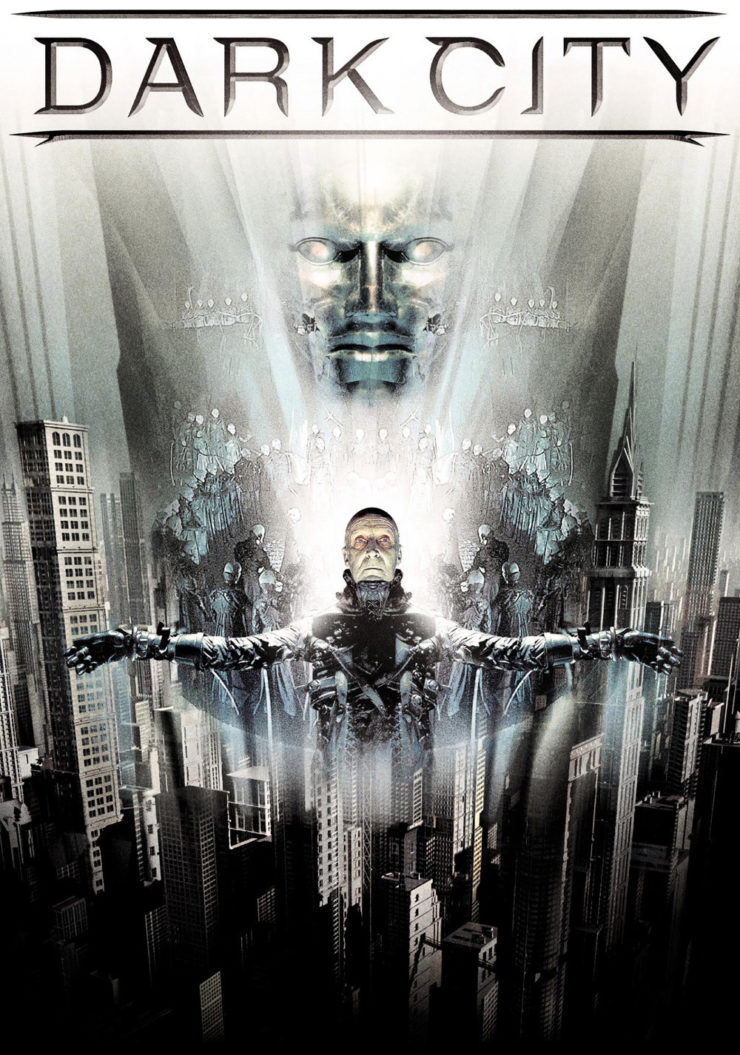Wait, don’t hang up, Tor.com! Do you find yourself lurking in shadows, memory gone, wondering if anything around you is real?
Well then, you’ll fit right in with this post, for today’s Movie Rewatch of Great Nostalgia covers one of my personal faves, 1998’s dark and twisty neo-noir offering of Dark City!
Previous entries can be found here. Please note that as with all films covered on the Nostalgia Rewatch, this post will be rife with spoilers for the film.
And now, the post!
ME: So, what do you know about Dark City?
LIZ: Um. That there’s… a city. And… it’s dark?
ME: Ehhxcellent.
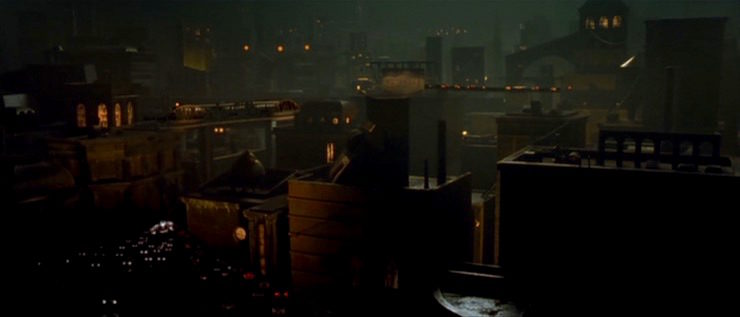
Yes, so before we begin, I have a heartfelt plea: if you have not already seen Dark City, please please PLEASE watch it before you read this post, because I am going to spoil the hell out of it, and you really don’t want to spoil yourself for this movie if you can avoid it. Going into this movie unspoiled was one of my favorite cinematic experiences of the 1990s, so if you have managed to remain unaware of Dark City’s plot till now, do yourself a favor and keep it that way until you have a chance to watch it. Sister Liz, clearly, is one such person, and so this viewing of the movie was her first. I was terribly excited to see what she thought of it.
(Sister Kate will not be joining us for this one; we looked at the manic eleventh-hour maid-of-honor-duty wedding madness in her eyes and wisely backed away let her off the hook this go-round.)
Concurrent to that plea: if you can possibly arrange to watch the director’s cut of this movie instead of the theatrical release, please please do that too. Remember how I complained about the plot-twist-destroying placard at the beginning of Logan’s Run? Well, the theatrical cut of Dark City has one too, in voiceover form, and its cat-out-of-bagging is about ten times worse than Logan’s Run, if you ask me. The director’s cut, on the other hand, doesn’t insult your intelligence and is just generally better than the theatrical cut, which just goes to show you that not all director’s cuts are created equal.
Got all that? Good, off you go.
Back? Yay! Let’s reminisce! About the movie you possibly just saw five minutes ago for the first time!
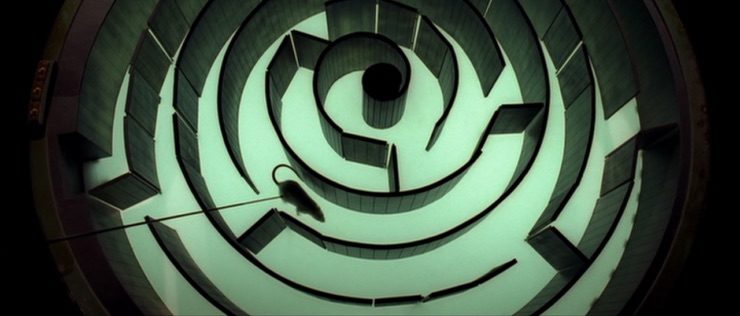
Now, you may be like, why do you love this movie so much, Leigh. It didn’t do all that well at the box office, and hasn’t really seemed to develop a cult following since it came out in 1998. And usually, at least one of those two things is necessary for an SF movie to be considered Important to the genre.
Well, first of all, I answer, Shirley you have noticed by now that the SF things I adore, especially as a young ‘un, do not necessarily bear any relation to whether or not they were popular in the mainstream, because pfeh. And secondly, there were some very particular aspects to this film that were practically tailor-made to delight my secretly dark and twisty inner moppet moviegoer. And lastly, I think Dark City was a lot more important to the SF genre than most people realize.
A thing you should know about me if you don’t already is that I am a huge, huge fan of the in medias res style of storytelling. I absolutely love when a story throws you into the middle of a confusing but fascinating situation and gradually clues you in, like you’re discovering the story instead of being told it. (It should probably surprise no one, given this, that Myst and its ilk are my absolute favorite kinds of games to play.)
I feel that when done well, in medias res stories engage and invest the viewer/reader in a way that almost no other narrative technique can match. And Dark City (or at least the sans-stupid-voiceover version of it) is a quintessential example of an in medias res story.
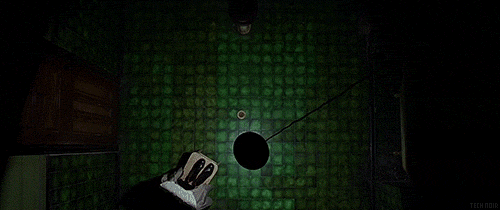
We begin knowing just as much about what’s going on as our protagonist John Murdoch does, which is to say, not a damn thing. (Delicious.) And so we follow right along with him as he slowly uncovers layer after layer of his situation, from the already disturbing surface interpretation (that John is a psychotic serial killer with amnesia), down to the far weirder truth behind that (that John—and everyone else in the city—is an unwitting lab rat for parasitical aliens), all the way down to the freakiest truth of all (that John has the ability to defeat the aliens with their own powers).
Very onion-like, this movie is, and I heart it. And it certainly doesn’t hurt that the “tuning” power John shares with the aliens is basically telekinesis turned up to 11, and we already know how much I adore stories about psychic phenomena. So really it would have been odder if I hadn’t loved this movie, all things considered.
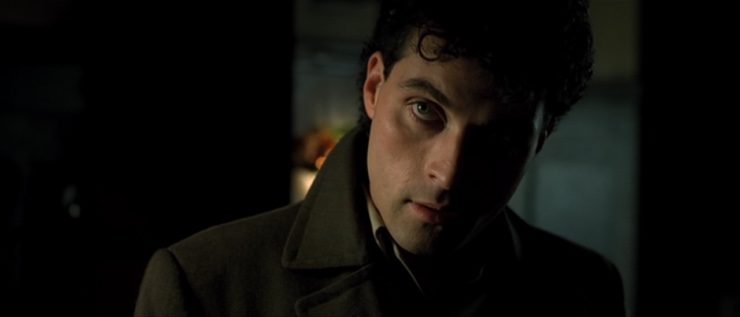
The other thing to love (mostly) about this movie is the cast.
I have always very much enjoyed Rufus Sewell as an actor, and this movie is the reason. Most of the time he plays villains, and he is undeniably skilled at it (to the point that I nominated him to play the Second Biggest Big Bad in the nascent Wheel of Time TV series), but what I loved about his casting in this movie is that his character John Murdoch had to be ambiguous. Especially at the beginning, John had to be believable to the audience as either the hero we’re rooting for or, possibly, the remorseless killer we want stopped, and Sewell rode that line wonderfully, in my opinion.
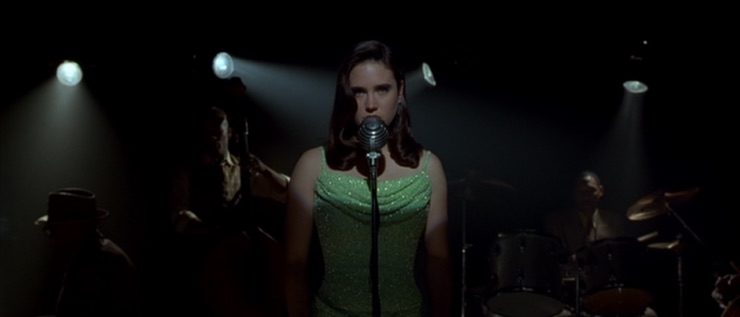
And Jennifer Connelly was perfect, as far as I’m concerned. Not only for her eerily exquisite beauty (seriously, that much gorgeousness in one person verges on the freaky), but in the effortless way she exuded Emma’s quiet melancholy and subtle confusion at living a life she senses, however dimly, isn’t really hers. Jennifer Connelly is, in my opinion, one of the most consistently underrated actresses alive, and her brilliantly understated performance in Dark City is a great example of why.
Interesting tidbit: in the theatrical cut, Connelly’s voice is dubbed over in her singing scenes by Anita Kelsey. And the thing is, I get why, because Kelsey’s voice is lovely, and I actually quite like her cover of both songs in the film. But Liz and I both agreed that it was much better that the director’s cut kept Connelly’s own voice, even though she is not quite as good a vocalist, because the whole point is that Emma isn’t a lounge singer; she just currently has memories that tell her she is one. You can even see it in Connelly’s body language, how Emma doesn’t quite look comfortable up on stage the way a seasoned performer would. (Did I mention she’s brilliant?)

Also effortlessly brilliant is the ubiquitous William Hurt, who seems to be in everything, and makes everything better for it. His Inspector Bumstead takes the noir stereotype of the world-weary hard-boiled detective and infuses him with a strangely gentle air of grief that gives the character a lovely depth and humanity. The scenes he and Connelly have together are almost enough to break your heart without either of them even needing to say a word. Sheesh.
And then there’s Kiefer Sutherland.
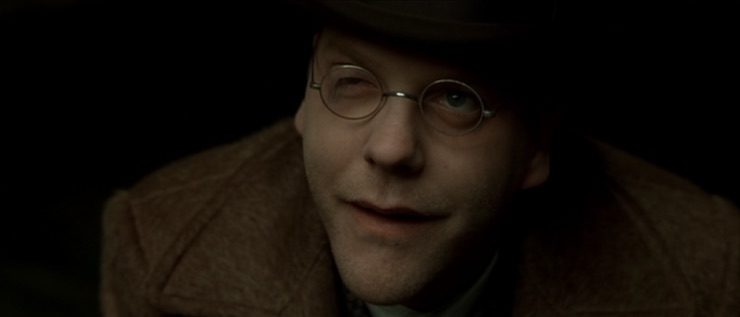
Don’t get me wrong, I love me a Kiefer even when he’s in objectively terrible projects (or busy promoting torture as a viable anti-terrorism tactic), but his Dr. Schreber in Dark City was one of his less awesome efforts, I think. Liz comments that she wouldn’t have minded the Igor vibe so much if they hadn’t also made him the infodump character. You do have to wonder about the choice to give the character with by far the most lines in the film a speech impediment.
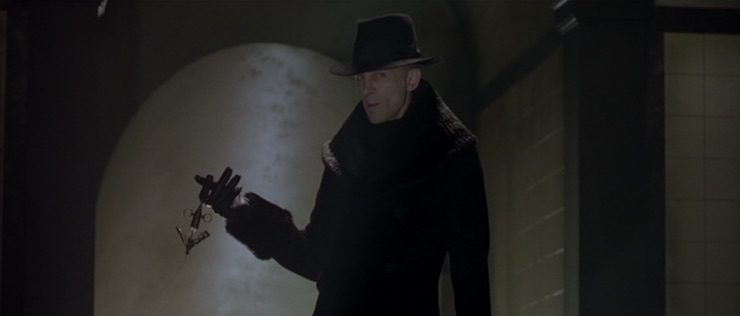
ME: He’s just a jump to the left!
Yeah, so, in more fun trivia, that is indeed Richard O’Brien of Rocky Horror Picture Show fame as main-ish bad alien guy Mr. Hand. Wikipedia claims that director Alex Proyas in fact based his design for the Strangers on O’Brien’s character Riff Raff in Rocky Horror, long before O’Brien was actually cast in the role. So that’s fun, and in general the actors all did a great job of making their characters complement the world they inhabited.
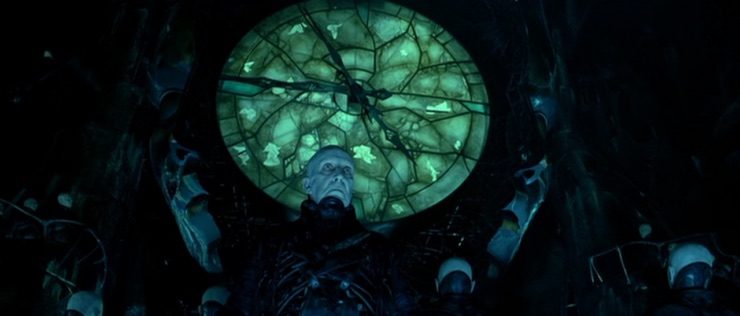
And the world they inhabit is a pretty darn disturbing one. The more you think about it, in fact, the more disturbing it becomes. Like, how long have the human guinea pigs been in the city? The production design is a (deliberate) mishmash of various periods of the twentieth century, but for all we know the aliens could have abducted the humans many centuries ago, and have been playing with them on their fake mini-planet ever since. Eesh.
John Murdoch’s good/evil ambiguity by no means stops with the revelation that he is not a serial killer, either. The Kiefer Lifetime University memory implant gave John the knowledge of how to defeat the Strangers, but it seems that Dr. Schreber didn’t quite think about the implications beyond that point.
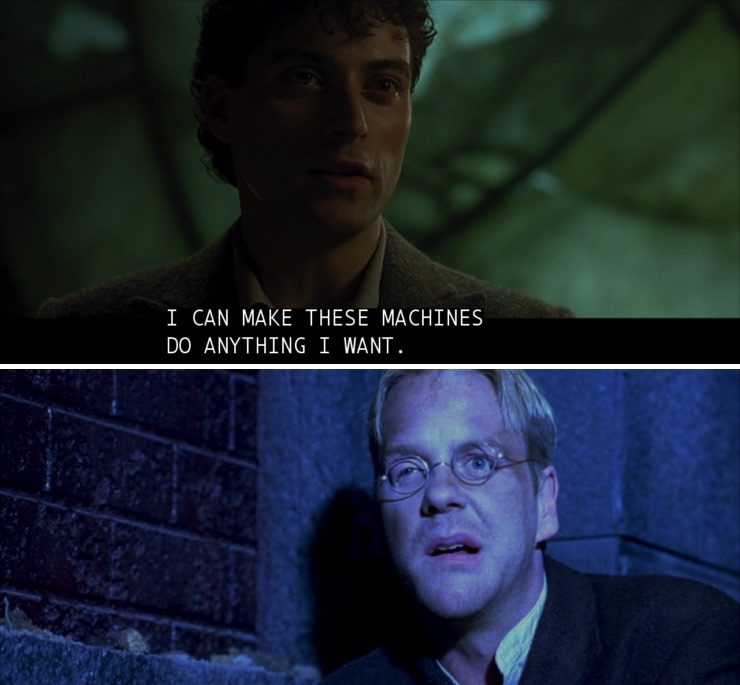
LIZ: Yeah, he should have maybe thought about how he was creating God.
Seriously. Because, yeah, we only see John do good things with his phenomenal cosmic power at the end of the film, like fix the buildings and make the sun rise and give Anna/Emma a beach, but the potential for abuse there is endless, and it’s really a pretty dark, ha ha, ending if you consider the deeper implications of it.

But maybe it was all of a piece, and meant to be that way, because the other other thing to love about this movie is that it is visually and aesthetically united in awesome.
The production’s devotion to the harmony of the film’s atmosphere, through color palette, lighting, camera filters, set design, costumes, everything—is just spectacular, in my opinion. Even more so when you consider what a mélange of influences Dark City’s director Alex Proyas was drawing upon to create the film’s look. Everything from the stark German Expressionism of 1927’s Metropolis to the shadowy allure of World War II-era film noir to the grim urban despair of Terry Gilliam’s Brazil to the macabre moodiness of The Twilight Zone to even the demented stylizations of Tim Burton are in there, all blended together into something we instantly recognize but have never quite seen before.
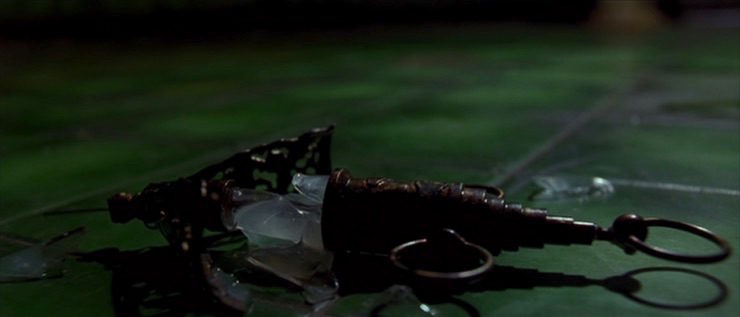
LIZ: It’s something I recognize from a lot of stuff that came out after 1998, too.
True. It’s been noted more than once the similarity of Dark City’s aesthetic to that of The Matrix, which came out a year later. In fact, The Matrix used several of Dark City’s sets: the staircase Inspector Bumstead chases John down, for instance, is the same one where Neo saw the déjà vu cat.

You can see Dark City’s influence in a lot more than just the Matrix movies, too. Christopher Nolan has said that the film was one of his inspirations for Memento and what would eventually become Inception, and I’d be very surprised if the folks behind Sin City weren’t fans as well. Other later SF films like The Thirteenth Floor, Minority Report, and Equilibrium may not have drawn inspiration directly from Dark City, but if they didn’t then they drew on The Matrix, which was etc.
LIZ: That was a cool thing, but it was also sort of a drawback, too.
Which is something many of you may be thinking as well. The problem for Liz was that, having seen The Matrix and Inception and all the other things that came after Dark City before seeing Dark City itself, the impact of the film was a bit blunted for her. Sort of like (on a much larger scale) watching Citizen Kane three quarters of a century later and not getting why it was such a big deal, because literally everyone since then has used and improved upon the filmmaking and storytelling techniques it pioneered.
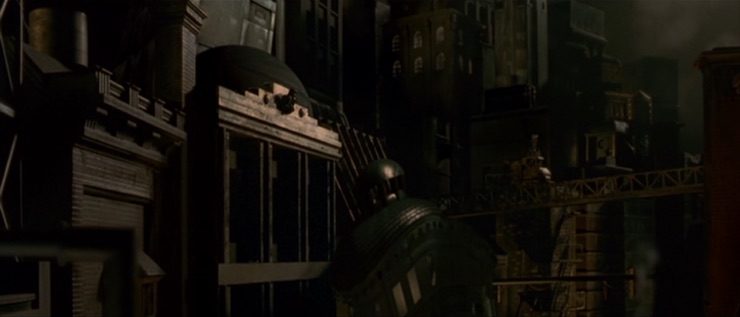
LIZ: I can see why those later films did better than this one, because they took what Dark City did and expanded it. Like The Matrix took it and went to the next level with the action, and Sin City went to the next level graphically—
ME:—and Memento went to the next level of mindfuckery—
LIZ: Right, and so on. Dark City was really good, but because I’d seen all those movies first, it just wasn’t quite as impressive.
I admit I pouted a bit about that, but then I was lucky enough to see Dark City and all those other films in the “right” order, so I suppose I can’t necessarily expect Liz or anyone else who didn’t to have the same affection for it that I do. However, I do hope that after this you understand why I love it so much, and why I think it deserves a place of honor in the SF movie genre—for how much it influenced those that came after it, if for no other reason.

And that’s what I got for this one! Which means it is time for our nearly-as-ubiquitous-as-William-Hurt Nostalgia Love to Reality Love 1-10 Scale of Awesomeness!
For Liz:
Nostalgia: 0, because duh
Reality: “I give it a solid 7”, she says. Sigh.
For me:
Nostalgia: 9
Reality: 9.5
And now, tell me your thoughts, I want to hear them! Talk amongst yourselves, and then come back in two weeks for another MRGN, ya heard me? Cheers!










